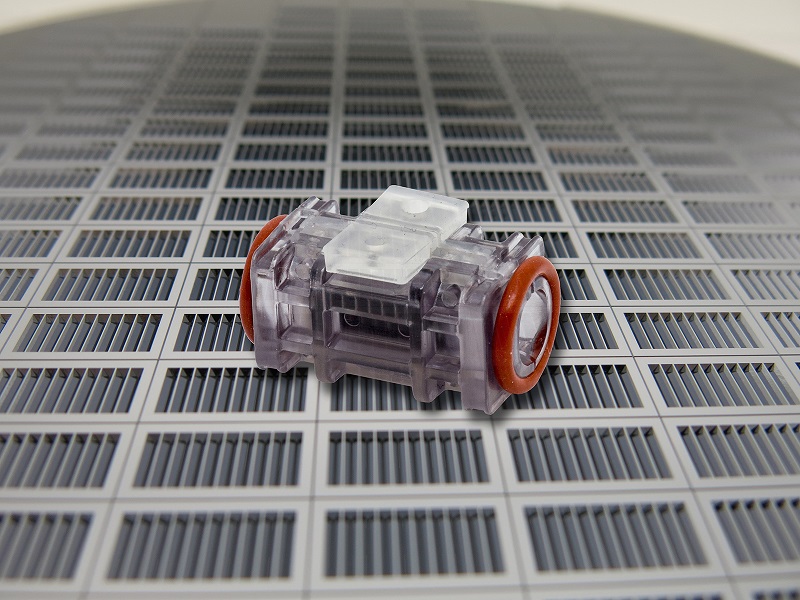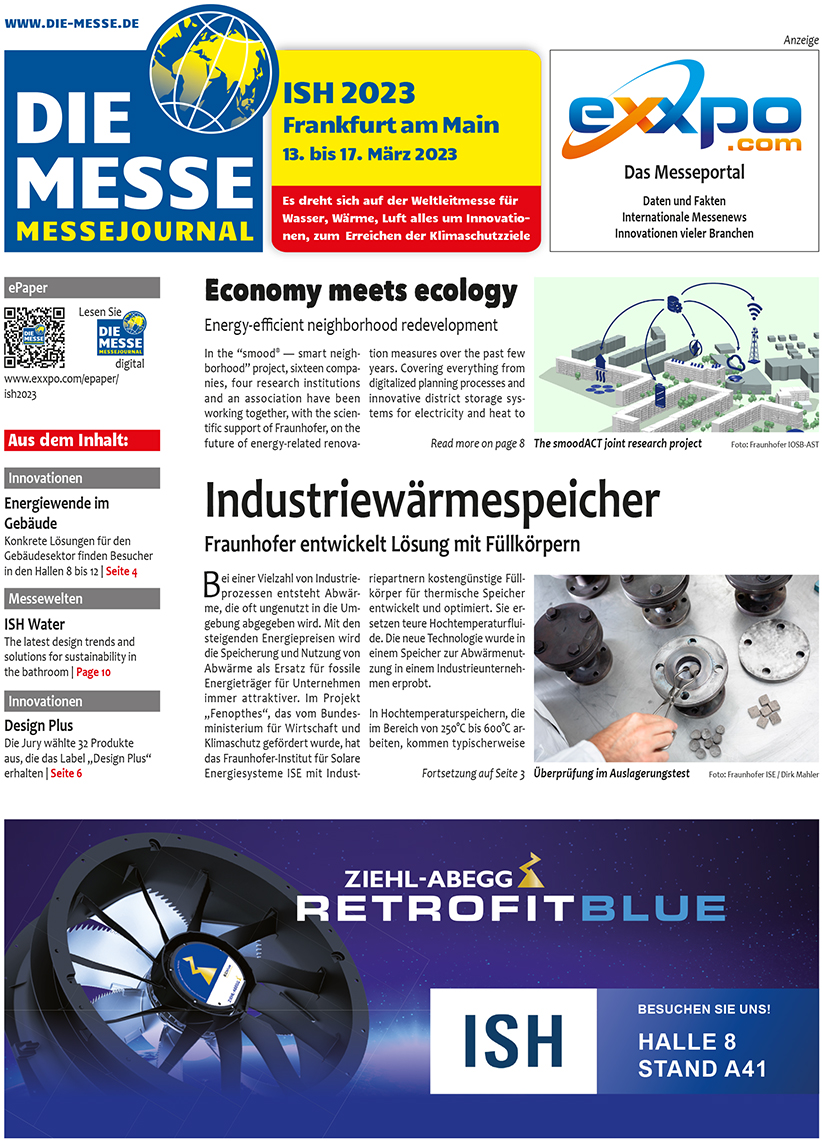Water hygiene: Water disinfection with ozone
While chlorine and ultraviolet light are the standard means of disinfecting water, ozone is equally effective in killing germs. To date, ozone has only been used as an oxidation agent for treating water in large plants. Now, however, a project consortium from Schleswig-Holstein is developing a miniaturized ozone generator for use in smaller applications such as water dispensers or small domestic appliances. The Fraunhofer Institute for Silicon Technology ISIT has provided the sensor chip and electrode substrates for the electrolysis cell.
 Foto: Fraunhofer ISIT Foto: Fraunhofer ISITThe electrodes for the ozone generator are made of silicon wafers with precisely etched trenches. |
Direct production of ozone via water electrolysis
“The ozone generator is very compact and can be integrated in systems and appliances that require regular disinfection,” says Norman Laske, researcher at Fraunhofer ISIT. “You simply connect it up to the water line, and it will produce the right amount of ozonized water whenever required.” The ozone generator is only a couple of cubic centimeters in size and comprises an electrolysis cell, a sensor chip, control electronics to regulate current and voltage, and electronics to read the sensor signals. “The two electrodes are separated by an ion-conducting separator membrane,” Laske explains. “When a voltage is applied across the electrodes, the water is split by a process of electrolysis. Because of the diamond layer coating the electrodes, this process first forms hydroxyl radicals, which then react to form primarily ozone (O3) as well as oxygen (O2).”
Diamond-coated silicon electrodes
How the electrodes with their boron-doped diamond layer are made is the know-how that has given CONDIAS GmbH its name. The company already uses a chemical vapor deposition process to coat large-scale electrodes required to disinfect the ballast water of marine vessels. However, the electrodes required for the MIKROOZON generator are much smaller. They are made of silicon and have finely etched trenches that run through the electrodes to form narrow slits on the reverse side. In order to be able to etch these trenches with the required precision, the researchers from Fraunhofer ISIT had to have wafer material manufactured to their own specifications.
To build an ozone generator, pairs of these electrodes are mounted back to back, with a separator membrane between them. The gases are released at the interface to the separator membrane and then escape through the trenched structure to the other side of the electrode, where the turbulence of the water flow ensures that they are efficiently dissolved and dispersed.
The sensor chip from Fraunhofer ISIT is equipped with three sensors to measure conductivity, mass flow and temperature. These parameters need to be monitored in order to control the electrolytic process. The sensor chip provides the data that is required to control ozone production in line with the quality and the amount of water used. “In order to ensure that there is enough ozone available over the period required, the temperature has to be monitored,” Laske explains. “This is because ozone decomposes more quickly at higher temperatures.” Conductivity correlates to the degree of water hardness: the harder the water, the higher the conductivity – meaning that more current must flow in order to achieve the desired effect. When equipped with a system to monitor these parameters, the ozone generator should be capable of processing up to 6 liters of water per minute – without the sensor chip, it is currently specified for 0.5 to 1.5 liters.
CONDIAS is marketing the minigenerator under the brand name of MIKROZON®. “Each partner has contributed years of experience from their own area of specialization,” says Volker Hollinder, CEO of CONDIAS GmbH. “This has created a product that can now be manufactured on an industrial scale. The spread of the coronavirus has underlined the importance of disinfection. The use of chemical disinfectants is often problematic, because they leave harmful residues. Our system uses electrolytically generated ozone to eliminate germs. It therefore does not produce any residues from disinfectants.”
More news about "ISH":
12 February 2023
ISH 2023: A vibrant host of events, lectures, talks and guided tours
ISH 2023 from 13 to 17 March is being held under the motto ‘Solutions for a Sustainable Future’. The trade fair in Frankfurt is the international meeting place for the sanitary and HVAC sector. (more…)20 December 2022
ISH 2023 interim result: growing anticipation
The focus of ISH - The world’s leading trade fair HVAC + Water, from 13 to 17 March 2023, is on marketable solutions for a sustainable future. Currently, the organisers are expecting around 2,000 companies to present their solutions for renewable sources of energy, sustainable water usage and clean air at the leading international trade event for the HVAC and water sector. (more…)31 March 2021
Green Deal, life-giving air or the hygiene trend in the bathroom – the first digital edition of ISH, the world’s leading trade fair for HVAC + Water, put the spotlight on themes of social, political and economic importance. A total of 373 companies presented their innovative products at ISH digital 2021. (more…)11 January 2021
ISH digital 2021: Keeping track of developments via future-oriented topics
Against the background of the Covid-19 pandemic, the world’s leading trade fair for water, heating and air-conditioning will bring the sanitation and HVAC sector together online from 22 to 26 March 2021. The aim: to link exhibitors, visitors, experts and journalists for five days, to offer high-grade content and to present a comprehensive programme of events. (more…)10 January 2019
The importance of air at ISH: good air quality pays off
The ground-breaking advances in the refrigeration, air-conditioning and ventilation technologies can be experienced first-hand at ISH, from 11 to 15 March 2019 in Frankfurt am Main. With over 2,400 exhibitions, ISH is the world’s largest show for the combination of water and energy. (more…)3 January 2019
New study “Global Visitor Insights” published
According to a new Global Visitor Insights study, trade show visitors globally are reporting a stable overall satisfaction with the shows they attend – but at the same time, between 22 and 27 per cent of show visitors from mature markets feel that shows are "getting worse". (more…)2 July 2018
Koelnmesse establishes subsidiary in Colombia
Koelnmesse is further expanding its presence on the Latin American market: With the establishment of the subsidiary Koelnmesse SAS in Colombia with headquarters in Bogotá, Koelnmesse is the first international trade fair organiser to be represented in this key Latin American trade fair market with its own subsidiary. (more…)
| FAIR NAVIGATOR | |||||||||
|---|---|---|---|---|---|---|---|---|---|
|
| E-PAPER ISH |
 |
